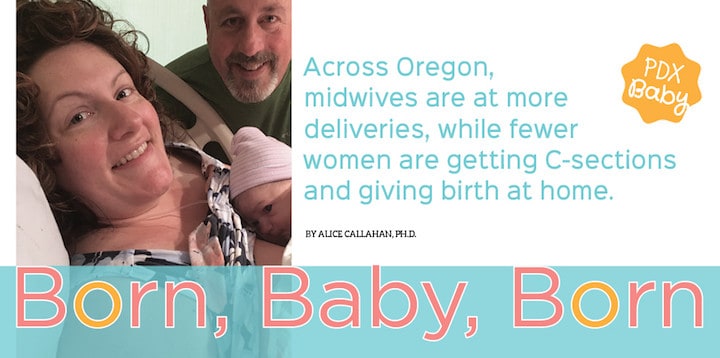
One brand-new Oregonian was born every twelve minutes in 2017.
That’s 44,115 individual birth stories that will be told time and again over the years.
But among those thousands of unique stories, some common threads emerge that, taken together, show an evolution in the way Oregon women are giving birth in the 21st century: Cesarean rates are falling, midwife-attended births are up and the popularity of home births may be leveling off.
A Decline in C-sections
Over the last few years, Oregon’s cesarean rate has slowly fallen, and among women who had a previous cesarean, data shows that more are having vaginal birth after cesarean, known as VBACs. Also included in this shift is a slight drop in elective C-sections, estimated to have dropped from 3.8 percent to 3 percent of births between 2009-10 and 2102-13.
That’s a start at leveling off a C-section rate that climbed 60 percent nationwide between 1996 and 2009 (with an even steeper increase of 74 percent in Oregon), with no evidence of improved outcomes for mothers or babies. Cesarean delivery is necessary and life-saving for some births, but it also increases postpartum recovery time and the risk of complications for both mother and baby.
Aaron Caughey, M.D., chair of obstetrics and gynecology at Oregon Health and Sciences University, says that his department supports VBACs and reviews every cesarean birth to make sure it was appropriate. But the fact that Oregon’s numbers for C-sections and VBACs are improving and better than the national average is at least in part thanks to the women of Oregon, Caughey says. “They are healthier, on average, than the rest of the country, and they have strong preferences towards less intervention, which helps drive the lower cesarean rate and higher VBAC rate,” he says.
In Oregon, as well as Washington, C-sections still account for about 27 percent of births, and 11 states have lower rates. (Utah’s is the lowest at 22 percent.) Estimates for ideal cesarean rates vary and likely depend on the population; a hospital that serves higher risk patients will have a higher cesarean rate, for example. A 2015 study comparing cesarean rates around the world found that when C-section rates were below 19 percent, maternal and newborn mortality were higher, illustrating that this level may be necessary. But above 19 percent, there were no improvements in mortality, only the increased risks associated with the surgery.
Call the Midwife
Obstetricians deliver the majority of babies in our state, as in the rest of the country, but over the last few decades, more and more Oregonian women have chosen certified nurse midwives (CNMs) as their primary birth attendant. In 2016, 21 percent of births in Oregon were attended by a CNM, compared with just 8.5 percent of births nationally.
CNMs have a nursing credential plus a master’s degree from a university-based midwifery training program, and most practice in a hospital setting. They tend to focus on low-risk pregnancies and provide individualized support for coping in labor, particularly for women with a goal of minimizing interventions. “It’s about helping her access her own capability to birth her own baby,” says Nora Tallman, a CNM at Women’s Healthcare Associates’ Midwifery Birth Center.
In a study published in February, Oregon ranked third in the nation for the level of integration of midwives into maternity care. (Washington ranked first, New Mexico second.) The study found that greater integration of midwives correlated with better outcomes for mothers and babies, including lower rates of cesareans, preterm birth, and neonatal death and higher rates of breastfeeding, spontaneous vaginal birth, and VBAC. These are correlations; a study like this can’t prove that midwives directly cause these outcomes, but it’s a finding that fits with other data and the experience of both midwives and obstetricians.
“If I had to guess, I think that integration of certified nurse midwives is a big part of reducing primary cesarean rates, and if I had to guess, I think it would also improve the maternal-patient experience,” says Rachel Pilliod, M.D., a maternal fetal medicine fellow at OHSU.
Tallman thinks there’s plenty of room for the role of midwives to grow but emphasizes that collaboration with obstetricians is essential. “Not all births go smoothly, and sometimes we really need the kind of medical capabilities that are beyond our scope of practice,” she says.
Fewer Home Births
Birthing at home or in a birth center has long been more common in Oregon and Washington than in other states, even as the out-of-hospital birth rate climbs across the United States. Oregon ranks fourth highest in the country for both home birth and total out-of-hospital births.
Compared to the statewide out-of-hospital birth rate of 3.5 percent, Multnomah County runs a bit higher at 4 percent, including 184 babies born at birth centers and 202 planned home births in 2017, based on preliminary data.
But in Oregon, out-of-hospital births have dropped over the last few years. Tallman says that’s probably because the Oregon Health Plan, the state’s Medicaid plan, has tightened the criteria for out-of-hospital births they’re willing to pay for, such that only very low-risk birth center and home births are now paid for by OHP. (In 2016, OHP paid for 44 percent of all Oregon births.)
Studies show that there are both benefits and risks to giving birth out of hospital. For example, a 2015 study conducted by Dr. Caughey and colleagues found that planned out-of-hospital births in Oregon were less likely to involve induction or augmentation of labor, forceps or vacuum delivery, or cesarean birth. However, out-of-hospital births had double the rate of stillbirth and newborn death (3.9 vs. 1.8 deaths per 1,000 deliveries) and a greater rate of low Apgar scores and neonatal seizures. Most home and birth center births are attended by Licensed Direct Entry Midwives (LDMs), who range widely in their qualifications.
Reducing the risks of out-of-hospital birth starts with good communication, says Pilliod. It means talking with women considering giving birth out of hospital about their individual risk factors (see Who Should Not Have a Home Birth? at left) and having open lines of communication with midwives so that women can be transferred to a hospital if necessary.
“Home births and birth center births are perfectly appropriate for the right candidates and under the right circumstances,” she says. But ideally, “if there are problems that arise, they can transfer early, and then we do a very good job of receiving that transfer without judgement,” she says. OHSU also offers free, 24/7 phone consultations so that birth providers, including midwives and doctors at other hospitals, can call in for advice on cases.
Birth centers offer midwifery care in a home-like environment well-stocked with medical supplies and prepared for emergencies or transfers. Portland has three birth centers accredited by the Commission for Accreditation of Birth Centers — Alma Midwifery, Andaluz Waterbirth Center, and the Midwifery Birth Center. The last of these was just opened last year by Women’s Healthcare Associates, a large physician group, which means obstetricians are always available to help manage care and provide backup if a woman needs to transfer to the hospital.
Room for Improvement
By many measures, Oregon does a good job of taking care of mothers and babies. In addition to our declining cesarean rate and growing integration of nurse midwives, we have one of the lowest preterm birth rates in the country. But there is room for improvement in these measures, and there are others that we aren’t measuring at all, such as how consistently hospitals are using research-backed practices during birth and the postpartum period. “We have incredibly poor metrics to measure the quality of care,” says Caughey, citing national problems with disjointed healthcare systems and medical record-keeping. “That’s not just Oregon, it’s everywhere.”
The Oregon Perinatal Collaborative is one group addressing this issue, working towards coordinated, statewide improvements in maternity care. By collecting data from Oregon hospitals, they are identifying areas for improvement and working to develop shared best practices.
One of the group’s first initiatives was to adopt a statewide policy limiting elective inductions or cesarean deliveries before 39 weeks. That began in 2011, making Oregon the first state to implement such a policy. As much as those last days of pregnancy can be a slog for the person carrying it, these early births increase the risk that the baby will end up with respiratory distress or in the NICU, and the policy has been effective at giving babies a bit more time to develop before birth.
Caughey, who chairs the Oregon Perinatal Collaborative, says its goal is “to make Oregon the best place in the country to have a baby. We want both for us to have low cesarean rates, but also the lowest neonatal and maternal morbidity and mortality along with the best patient experiences.”
Stephanie Haskell’s daughter, Simone, was born by VBAC at Kaiser Permanente Sunnyside last November. “I felt so strong and proud. The feeling that I was able to push my baby out of my body is like nothing else. An amazing experience,” says Haskell, of Vancouver, Washington, pictured here with her husband, Brian Haskell.
Charity Staudenraus of Beaverton chose midwifery care for her second and third babies, both born at Kaiser Permanente Westside Medical Center in Hillsboro. “I am passionate about the amazing experience I had birthing with midwives, but I’m also adamant that part of the reason I had such a great experience is because I was in the hospital with all of the safety measures and nurses available,” she says.
Zakiya Rhodes of Oregon City appreciated the calm and patient attitudes of her midwives from Women’s Health Associates, who attended her son Avery’s birth at Providence Willamette Falls Medical Center last March. “My little guy calmly came into this world surrounded by a great group of nurses and midwives.” Here, Avery meets his older brother.
“Home births and birth center births are perfectly appropriate for the right candidates and under the right circumstances. If there are problems that arise, they can transfer early, and then we do a very good job of receiving that transfer without judgement.” — Rachel Pilliod, M.D., a maternal fetal medicine fellow at OHSU.
Who Should Not Have a Home Birth?
Women considering home birth should talk with their healthcare provider about individual risk factors, like diabetes or high blood pressure, that make an out-of-hospital birth a riskier choice. The American College of Obstetricians and Gynecologists considers the following to be absolute indicators for a hospital birth:
• Breech presentation
• Multiples
• Prior cesarean delivery
Other important safety considerations include ensuring that a hospital is close, that there’s a plan for transport if needed, and that the midwife is certified by the American Midwifery Certification Board or meets the International Confederation of Midwives Global Standards for Midwifery Education.
- The Science of Sleep - April 29, 2020
- The Mental Impact of School Lockdown Drills - February 10, 2020
- Is Cannabis Safe During Pregnancy & Breastfeeding? - May 10, 2019






